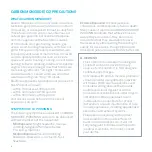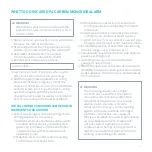
12
HEADS-UP AND EMERGENCY ALARMS ALERTS
ALERTS
When Nest Protect has something to say, it
will speak to you and light up instead of just
beeping. Nest Protect has two kinds of voice
alert: Heads-Up and Emergency Alarm.
When smoke or carbon monoxide levels
are heightened but haven’t yet reached
Emergency Alarm levels, Nest Protect can
sound a Heads-Up as an early warning.
Nest Protect will pulse yellow and tell you
where there’s smoke or carbon monoxide.
You’ll get an Emergency Alarm when smoke
or carbon monoxide reach critical levels.
Nest Protect will pulse red, tell you what
room the emergency is in and sound a loud
alarm. If there’s both smoke and CO present,
the smoke alarm will take priority.
SILENCING
Heads-Up alerts and Emergency Alarms can
be silenced by using the Nest app or pressing
the Nest button. Only silence an alarm once you
have checked conditions at the Nest Protect
that first sounded the alarm. Do not silence
Nest Protect by removing the batteries. This will
disable the alarm so that it cannot sense smoke
or carbon monoxide, leaving you at risk.
Because there are many different types of fire,
you may experience an Emergency Alarm
without having first experienced a Heads-Up
alert. This means that critical levels of smoke or
CO occurred extremely quickly and Nest Protect
had to sound the Emergency Alarm.
HAVE MORE THAN ONE NEST PROTECT?
After all the Nest Protects in your home are
connected to each other, if there’s a Heads-Up
or an Emergency Alarm in one room, they’ll all
tell you what the danger is and which room it’s in.
If multiple Nest Protects are interconnected,
a Heads-Up alert or Emergency Alarm can be
silenced only at the Nest Protect that originally
sounded the alert. You’ll need to go to that room
to silence all the Nest Protects in your home.
Always check the conditions near the Nest
Protect that first detected the smoke or carbon
monoxide before silencing it.
Summary of Contents for S3003LWES
Page 32: ...A13 64 10 0036 GB A ...













































